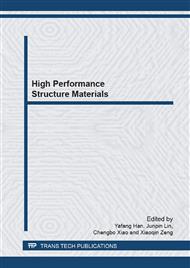p.665
p.672
p.678
p.684
p.690
p.697
p.703
p.709
p.715
Influence of Solution Temperature on Compositions Segregation and Creep Behavior of a Single Crystal Nickel-Based Superalloy
Abstract:
By means of solution treatment at various temperatures, creep properties measurement and microstructure observation, the effects of heat treatment on composition segregation and creep properties were investigated. Results show that the various segregation extents of the elements are displayed in the alloys solution treated at different temperatures, and the segregation extent of the elements is improved with the solution temperature elevated, which may obvious improve the creep resistance of the alloy. And no rafted structure of the γ phase is detected in the alloy during creep at medium temperature. The deformation features of the alloy during creep at medium temperature are that the slipping of dislocations is activated in the γ matrix channels, and dislocations shearing into the γ phase may be decomposed to form the configuration of partials + stacking faults, which may hinder the cross-slipping of the dislocations to improve the creep resistance of the alloy.
Info:
Periodical:
Pages:
690-696
Citation:
Online since:
February 2013
Authors:
Price:
Сopyright:
© 2013 Trans Tech Publications Ltd. All Rights Reserved
Share:
Citation:


